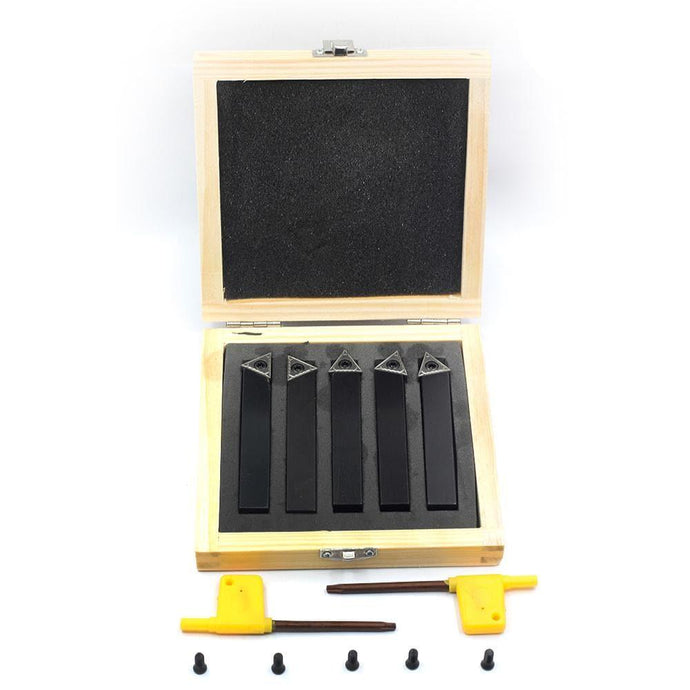In the world of modern machining, aluminum is one of the most commonly used materials due to its lightweight properties, strength, and corrosion resistance. From the aerospace industry to automotive and consumer electronics, aluminum is favored for its versatility and durability. However, machining aluminum requires specialized tools to achieve the precision and quality needed for high-performance components. This is where aluminum turning inserts come into play, offering manufacturers a cutting-edge solution to optimize aluminum turning processes. Designed to deliver precise cuts, improved surface finishes, and extended tool life, these inserts are essential for achieving efficiency and accuracy in aluminum machining.
Aluminum, while relatively easy to machine compared to materials like steel or titanium, presents unique challenges that require the right cutting tools. One of the main challenges is aluminum's tendency to form built-up edges (BUE) on cutting tools. As the cutting tool engages the workpiece, small pieces of aluminum can adhere to the tool's edge, leading to reduced cutting efficiency, poor surface finish, and potential tool failure. Aluminum turning inserts are specifically engineered to minimize this issue by using advanced geometries and materials that resist BUE formation. This ensures a cleaner, smoother cut, preventing the material from adhering to the tool and maintaining the sharpness of the cutting edge.
A key characteristic of aluminum turning inserts is the use of polished or highly honed cutting edges, which reduce friction and allow for smooth cutting action. These sharp edges are critical when working with soft metals like aluminum because they reduce the force required for cutting, leading to less wear and tear on the tool. The smoother the cutting action, the better the surface finish on the aluminum workpiece. Achieving a high-quality surface finish is crucial, particularly in industries like aerospace and automotive, where components need to meet stringent performance and aesthetic standards. Aluminum turning inserts are designed to deliver these high-quality finishes consistently, reducing the need for secondary finishing operations.
Another important feature of aluminum turning inserts is their ability to perform at high cutting speeds. Aluminum has high thermal conductivity, which allows it to dissipate heat quickly during machining. This means that tools designed for aluminum can operate at much higher speeds than those used for harder materials. Aluminum turning inserts are optimized for these high-speed operations, providing machinists with the ability to increase productivity without sacrificing precision. Faster cutting speeds translate into shorter cycle times, which are essential in high-volume production environments. The ability of aluminum turning inserts to maintain sharpness and durability at these elevated speeds ensures that manufacturers can meet demanding production schedules while maintaining consistent quality.
The versatility of aluminum turning inserts is another reason they have become a staple in modern machining. These inserts are available in various geometries and coatings tailored to specific aluminum machining applications. Whether performing roughing operations, where large amounts of material need to be removed quickly, or finishing operations that require high precision, aluminum turning inserts are designed to handle the specific demands of each task. Coatings like titanium nitride (TiN) or diamond-like carbon (DLC) are often applied to aluminum turning inserts to further enhance their performance. These coatings reduce friction, improve heat dissipation, and increase the tool's overall lifespan, making them even more effective in high-speed, high-production environments.
Durability is another important factor when selecting aluminum turning inserts. Although aluminum is softer than many other metals, the high-speed machining processes used to cut it can still generate significant tool wear. The advanced materials used in aluminum turning inserts, such as carbide or diamond-tipped inserts, ensure that the cutting edges remain sharp and effective for longer periods. This reduces the frequency of tool changes, minimizes downtime, and lowers the overall cost of the machining process. For manufacturers working with large quantities of aluminum, the durability and extended tool life of these inserts provide a significant cost advantage over less specialized cutting tools.
In addition to the practical benefits of aluminum turning inserts, they also contribute to more sustainable machining practices. Their longer tool life means fewer tool replacements, reducing material waste and the environmental impact associated with manufacturing and disposing of cutting tools. Furthermore, many aluminum turning inserts are designed to work effectively with minimal lubrication or cooling, reducing the need for excessive coolant use, which can be both costly and environmentally harmful. By improving efficiency and reducing waste, aluminum turning inserts offer a greener solution for manufacturers looking to optimize their processes.
In conclusion, aluminum turning inserts are indispensable tools for machining aluminum efficiently and precisely. Their ability to resist built-up edge formation, perform at high speeds, and deliver high-quality surface finishes makes them a preferred choice for industries that rely on aluminum components. As manufacturers continue to seek ways to improve productivity and reduce costs, aluminum turning inserts provide the precision, durability, and versatility needed to meet the demands of modern aluminum machining. Whether for aerospace, automotive, or general manufacturing, these inserts are critical in ensuring that aluminum parts are produced to the highest standards with maximum efficiency.


